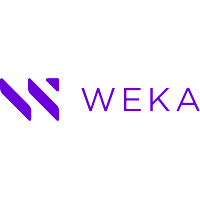The No. 1 feature of technology is storage. Ok, so that’s not true. But, it’s one of the critical pieces that enables software to function. How fast, how easy, and how much data can be accessed and leveraged inside of applications plays a critical part in technologies effectiveness and user experience. File systems have largely evolved unnoticed.
“Existing file systems written 20 years ago are like Microsoft word. It works, but you can’t collaborate with it. You don’t get the full effectiveness. In fact, if you had a project that started at night, and had to be done the next morning, everyone would overwrite everyone else’s work. And whoever was in charge would have a major headache, and the best work wouldn’t be done. In the case of a parallel file system, everyone gets the full use every single day to do as much work as they can. So there’s no latency, you’re not waiting for anything.”
Ken Grohe, President and CRO at WekaIO, a company that is working to solve those data and storage obstacles by eliminating and replacing legacy systems with a cloud-based collaborative file system structure, and we’re not talking about files like a spreadsheet. We’re talking about huge massive files like Electronic Medical Records, Gene Maps, and other critical files that now can be updated around the world like an excel file.
Hear how WekaIO played a role in Covid Vaccine development in a way that would not have been possible just a few years ago. Learn more about that plus other applications of modern file systems next, on IT Visionaries.
Main Takeaways
- Out of Storage: Nobody buys computers just because of their storage capabilities. But while storage is often overlooked, it is also the engine that powers the speed of your system. Currently there are three types of storage: Cloud, GPU and Flash. In order to create the fastest and most reliable system, your storage needs must be optimized for all three.
- What is a Weka-Byte?: According to research conducted by the Weka team, nine out of 10 big data centers are now operated by Weka. The reasoning for the shift? While most storage systems are designed with terabytes in mind, which are units of information which are equal to one million 1012, which is how traditional storage companies operate, a Wekabyte is considered 10100 , so nearly 10 times of the size.
- The Rise of the Data Chief: The newest member of the C-Suite is also becoming one of the most important members of leadership teams: The Data Chief. As more companies possess unstructured data, they are going to need someone with the data literacy and requisite knowledge to understand how to properly use that data.
For a more in-depth look at this episode, check out the article below.
Article
Here’s a hard truth: nobody buys a new device gushing about the amount of storage it carries. Megabytes, gigabytes, terabytes, who really cares? Instead, we covet that flashy piece of any new technology: bigger screen size, newer software, and maybe an improved processor. But at the heart of every device is storage, and while it might not be flashy, it’s the most important component of any system.
“Existing file systems written 20 years ago are like Microsoft word. It works, but you can’t collaborate with it. You don’t get the full effectiveness. In fact, if you had a project that started at night, and had to be done the next morning, everyone would overwrite everyone else’s work. And whoever was in charge would have a major headache, and the best work wouldn’t be done. In the case of a parallel file system, everyone gets the full use every single day to do as much work as they can. So there’s no latency, you’re not waiting for anything.”
With technology never seen before, comes data challenges never faced before. And WekaIO is working to solve those data obstacles by eliminating and replacing legacy storage systems. With storage infrastructure designed for the cloud, and optimized for flash storage, WekaIO can handle the trials and tribulations of today’s storage demands with lightning fast speeds.
On this episode of IT Visionaries, Ken Grohe, an experienced technology veteran and the President and CRO of WekaIO, dives into how storage is changing the way we collaborate in a distributed work environment, and why the Chief Data Officer is the newest member of the C-Suite.
According to Grohe, there are three defining trends in the storage infrastructure space; flash storage, which is often used in conjunction with legacy systems, the second is cloud storage, and the last is GPU.
“We’re at the crossroads of all three, which is really cool,” Grohe said. “What we do specifically is for every application, we tend to run 10 times faster. That includes mixed or a large workload, you can start as low 50 terabytes and grow to as large as multiple exabytes.”
Optimized storage at scale, while delivering speed with no latency. Sounds too good to be true, right? After all, various forms of files systems have existed for years, so what makes Weka different from the rest?
“What we do is a native, positive file system that has none of the roadblocks of the past,” Grohe said. “We started with a clean slate and basically said ‘What if the world was only flash-based, or only cloud-based, what if we only had accelerated computers?’…So they start with a clean sheet of paper to basically say, “What if we start with all over again?’”
By building its system from the ground up, WekaIO was able to design around the obstacles that most large-scale enterprises face: wanting to continuously innovate their applications, while protecting their data and infrastructure from the past. But to accomplish these goals, most companies had to sacrifice the speed at which they could operate and collaborate.
“The only way you can do that is using a parallel file system,” Grohe said. “Getting digital business done. That’s pretty cool, or solving modern data problems… It’s kind of just a modern data solution, where anything could be really solved and over time, that will really be the storage of the future.”
But while the future of data storage may lie in networks such as Weka, Grohe said he also believes that corporate structures are going to change as well to include new members of the C-Suite, including Chief Data Officers.
“ I believe the Chief Data Officer is uniquely positioned to be a bridge between the rigor, rules, discipline and the compliance of IT that has made the place breach-proof,” he said. “On the other side, what’s possible and what’s imaginable — the CDO does both.”
To hear more about how WekaIO is redefining cloud storage at scale, check out the full episode of IT Visionaries.
—
To hear the entire discussion, tune into IT Visionaries here.





